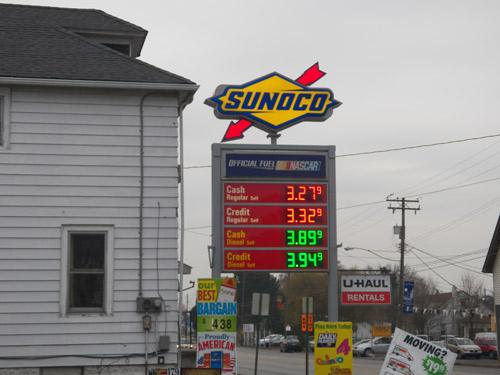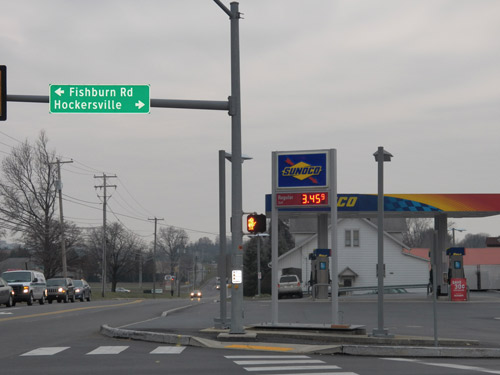Contrary to media reports, there will not be a 28 cents-per-gallon increase on January 1, 2014.
The state will immediately eliminate the 12-cents liquid fuels tax that is paid by motorists at the pump. These revenues will be picked up by a millage rate adjustment to the Oil Company Franchise Tax (OCFT).
For years, oil companies have been taxed based on the price of gas in 1983 (when the average price of gas was $1.24), thanks to an artificial cap. As part of the new funding structure, this cap will finally be removed to ensure these taxes are paid at current-day prices. This will be the first time in 30 years the tax on the major oil companies has increased.
This tax increase on oil companies will be spread out from January 2014 to January 2019. It will be lifted gradually each year for five years, eventually totaling a 28-cent-per-gallon increase. The cost to consumer, in reality is unknown because no one knows if the wholesaler will pass along the entire OCFT tax; currently, that is not done. If it was to be, and we were using the initial 9 cent increase, the cost to motorists would be approximately $10.80 more on a monthly basis.
However, it’s important to understand that the price we pay per-gallon of gas can depend on a variety of factors, including location.
For example, the photos below, taken on Dec. 3, 2013, show two different gas stations run by the same oil company. They are only located within a couple miles of each other, but their prices vary by nearly 20 cents per gallon.
 |
| |
 |
| Why are they nearly 20 cents apart? Because they can. One station is on Rt. 322, and traffic from Hersheypark, the Hershey Lodge and the Hershey Medical Center passes by this location. |
| |
 Sunoco in Derry Township, 2-6-14 Sunoco in Derry Township, 2-6-14 |
| |
 Turkey Hill on Rt. 230, 2-6-14 Turkey Hill on Rt. 230, 2-6-14 |
| |
 Sunoco on Rt. 230, 2-6-14 Sunoco on Rt. 230, 2-6-14 |
| |
In addition, under the new law, driver’s license and vehicle registration fees will increase a total of $2 over five years.
Overall, the taxes and fees in Act 89 of 2013 are drastically less than the initial plan (Senate Bill 1) that was proposed and passed by the Senate in June.
Click here to view a comparison of Senate Bill 1 and House Bill 1060. |
Transportation By the Numbers
- Pennsylvania’s 41,158-mile highway system is larger than the state road systems of New York, New Jersey and the New England states combined (40,092).
- Approximately 36 percent of the state roads are considered “poor” or “mediocre” condition.
- The state is responsible for 25,321 bridges.
- Structurally Deficient Bridges: 6,536 total.(4,293 state; 2,243 local.)
- Weight-restricted bridges: 2,528 total. (829 state; 1,699 local.)
- Closed bridges: 256 total. (42 state; 214 local.)
What Transportation Investments Mean to Pennsylvania
Pennsylvania, sadly, is first in the nation with the number of structurally deficient bridges, and in the top half of having among the worst road conditions. Poor road conditions, traffic congestion and outdated features are estimated to cost state motorists more than $9 billion a year in vehicle-operating costs, crashes and road delays.
Click here to view local media support for the transportation funding plan.
Safety First: With more than 6,500 structurally deficient bridges statewide, Pennsylvania is the worst state in the nation for ensuring the safety of the bridges our family cars, school buses and industry trucks drive over each day. We have all seen the deteriorated bridges. Does anyone feel comfortable allowing school buses to cross? Isn’t it time our emergency services are allowed to cross every bridge in the Commonwealth? This package will help move us from worst to first in protecting our citizens.
50,000 Jobs Created: A maintained transportation system is also an important advantage in the competition for jobs and economic growth. The comprehensive transportation funding package will create more than 50,000 new jobs for our citizens and their families. In addition, the state will save 12,000 jobs that would have been lost without a new transportation commitment.
$1 Billion Saved: PennDOT will be required to implement $1 billion in cost-savings and efficiencies over the next decade alone. Our hard working families deserve to know that each and every dollar invested will be stretched as far as possible.
Long-Term Prosperity: Investing in our infrastructure helps build the foundation upon which we can promote and advance a successful 21st century economic development strategy.
Helping Our Local Governments
Municipalities maintain approximately 78,000 miles of road and nearly 6,400 bridges. Currently, municipalities receive approximately $300 million in Liquid Fuels Tax allocations; they spend at least $1.3 billion annually. The bill provides:
- A 60 percent increase a year in Liquid Fuels allocations statewide for local roads and bridges by the fifth year.
- Dauphin County municipalities are expected to see an additional $4.9 million per year in Liquid Fuels allocations for local roads and bridges by the fifth year.
- Up to $40 million in PennDOT grant money by 2016-17 to coordinate traffic signals to alleviate congestion and save fuel.
- New funds to pave low-volume rural roads (dirt and gravel).
- Local savings of up to 20 percent local match per bridge under PennDOT’s bridge bundling program.
Needed Reform for the PA Turnpike Commission
This legislation will bring more accountability to the management of the PA Turnpike and strengthen oversight, including:
- A performance audit by the auditor general every two years.
- Appearance by Turnpike Commission officials before the Legislature every June.
- Reinstated term limits for Turnpike Commissioners.
What Does it Mean for the 106th District?
PennDOT develops a Twelve-Year Transportation Improvement Program (TIP), which targets the Commonwealth’s improvement efforts in all major transportation modes: highways, bridges, aviation, rail and transit. In order for a project to become part of the plan, it must go through a multi-step process for approval and funding.
Since I was elected, there has been no increase in lane capacity projects approved for the TIP. The only projects completed in our area in the last ten years have been repaving, intersection safety improvements and emergency bridge work.
Examples of additional projects that need addressed in the 106th District would include: adding a lane to Interstate 83 at the 19th Street bottleneck, improving the interchange at Rt. 283 and the Pennsylvania Turnpike and adding a right-hand turning lane from Middletown Road onto the service connector road.
The transportation bill passed at the end of November allows for all of the above projects and many more to occur during the five-year phase in of the legislation.
Johnstown Tribute Democrat Analysis: The 106th District of Dauphin County Republican John Payne stands to get the largest influx of road construction cash if the House passes a transportation plan that spends at least as much as the $1.8 billion a year proposed by Gov. Tom Corbett earlier this year.
Click here to view a list of transportation projects expected to take place in the 106th District in 2014-2016.